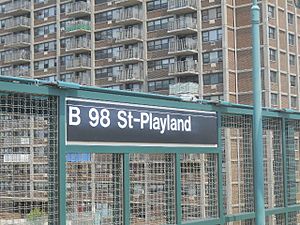Rockaways' Playland facts for kids
Rockaways' Playland was a popular amusement park located in Rockaway Beach, Queens, New York City. It opened in 1902 and entertained visitors until 1987. The park was created by roller coaster designer LaMarcus Adna Thompson. Later, it was owned by Robert Katlin and then by A. Joseph Geist. Between 1928 and 1970, Rockaways' Playland was incredibly successful, drawing 175 million visitors. It eventually closed because the cost of insurance became too high.
Contents
A Look Back: The History of Playland
Thompson's Early Park
The land where Playland stood was first developed as a resort in 1876. In 1900, George Tilyou, who owned Steeplechase Park in Coney Island, bought some land in Rockaway Beach. Around the same time, roller coaster designer LaMarcus Adna Thompson faced financial trouble. Tilyou offered Thompson two acres of land, which Thompson bought by 1901.
Thompson's park opened around 1901, 1902, or 1903. It was known simply as Thompson's Amusement Park. It stretched all the way to the Rockaway Beach and Boardwalk. By 1905, Thompson was running the park himself. It was one of many fun places along Rockaway Beach. A ferry dock was added in 1903, making it easy for people from other parts of New York City to visit.
After Thompson passed away in 1919, his family continued to operate the park for eight years. In December 1927, they sold it to a group led by Robert Katlin. Katlin then added new features like an arena, a gym, and a swimming pool.
The Geist Era: Playland's Golden Age
In January 1928, Queens lawyer A. Joseph Geist bought the park. He renamed it Rockaways' Playland. Soon after, he began to expand it, adding a dance hall, an animal display (menagerie), and a new roller coaster. Geist added many more attractions in the early 1930s. By 1936, he advertised that the park had 24 different rides and games.
In 1937, New York City parks commissioner Robert Moses tried to close the amusement area. He wanted to build the Shore Front Parkway through the park. Playland lost half of its rides because of this project. Moses also tried to close nearby bungalows, but Playland survived. After spending between $3 million and $5 million on rebuilding, Geist reopened Playland in 1939.
Playland's attendance dropped during World War II. A wartime blackout meant the park's lights had to be turned off to avoid enemy detection. The blackout ended in August 1945. More attractions, including a special area for young children called Joytown, were added in 1949. The following year, a $1 million project brought new lighting systems to the park. Visitors continued to come from places like Jersey City, Lower Manhattan, and Yonkers. Ferry services also started, connecting Playland to Sheepshead Bay, Brooklyn in 1954 and Westchester in 1964.
Throughout the 1950s, Playland hosted many special events. In 1953, for example, six hundred orphans were brought to the park for a fun day. When Geist died in 1960, his son Richard took over. Richard added many contests, such as beauty pageants on Monday evenings and children's contests on Saturday afternoons. Playland saw a small dip in visitors during the 1964 New York World's Fair, but attendance quickly returned to normal. By 1970, Playland had welcomed 175 million visitors since A. Joseph Geist bought it. However, attendance started to decline in the late 1970s as the rides began to feel old.
The 1985 season was the last time Playland operated. At that point, Richard Geist did not plan to close the park forever. However, the next year, insurance costs increased hugely. The insurance premium jumped from $50,000 in 1985 to $408,000 in 1986. Because of this massive increase, Geist decided not to reopen the park. After Playland closed, plans were made to build homes on the site. The land was still empty in 1995 but had been developed by 2003. Today, the Beach 98th Street station of the New York City Subway still has "Playland" in its name.
Exciting Rides and Attractions
When Thompson's Amusement Park first opened, it featured a steeplechase-style ride. On this ride, people would race along a track on horse-shaped vehicles. The park also had a large bathhouse on the boardwalk. There was a midway area with a funhouse, a Skee-Ball ramp, and a shooting gallery. The first roller coaster in the park, called the Gravity Wonder, was added in 1924. A "tent city" with small cabins was located on the northern part of Thompson's Amusement Park.
In 1928, a large Olympic-size swimming pool was added to Playland. This pool was even used for tryouts for the Summer Olympics. An 8,000-seat arena was also built. Before it was taken down in 1930, this arena hosted circuses, church services on Sundays, and boxing matches on Fridays. A dance hall, a gymnasium, and an animal display were also added. A bathhouse with 5,500 lockers was built for visitors.
In 1930, Geist added a "Noah's Ark" attraction where the arena used to be. This ark looked like Mount Ararat and was a walk-through exhibit. Inside, visitors could hear the sounds of rain, thunder, and Noah giving orders. Other new rides in the early 1930s included flat rides like the Rig-a-Jig, Leaping Lena, Cave O'Laffs, and the Pretzel. A wooden roller coaster called the Atom Smasher was added in 1938. Designed by Vernon Keenan, it was 3,000 feet long and reached a height of 70 feet.


